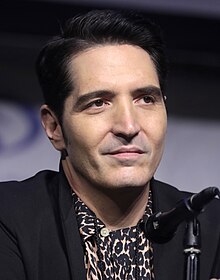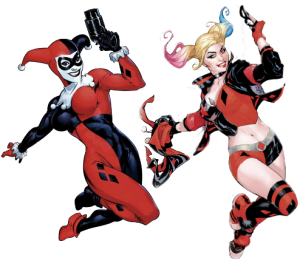
Harley Quinn is a character appearing in American comic books published by DC Comics. She was created by Paul Dini and Bruce Timm for Batman: The Animated Series as a henchwoman for the Joker, and debuted in its 22nd episode, "Joker's Favor", on September 11, 1992. While intended to appear in one episode, Quinn became a recurring character within the DC Animated Universe (DCAU) as the Joker's sidekick and love interest, and was adapted into DC Comics' canon seven years later, beginning with the one-shot Batman: Harley Quinn #1. Quinn's origin story features her as a former psychologist at Gotham City's Arkham Asylum who was manipulated by and fell in love with the Joker, her patient, eventually becoming his accomplice and lover. The character's alias is a play on the stock character Harlequin from the 16th-century Italian theater commedia dell'arte.
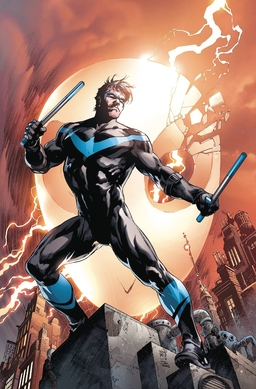
Nightwing is the name of several superheroes appearing in American comic books published by DC Comics. The most prominent is Dick Grayson, who takes the name when he leaves his role as Batman's partner and sidekick Robin in his adulthood.

Hugo Strange is a supervillain appearing in comic books published by DC Comics, commonly as an adversary of the superhero Batman. The character is one of Batman's first recurring villains, and was also one of the first to discover his secret identity. The character first appeared in Detective Comics #36.
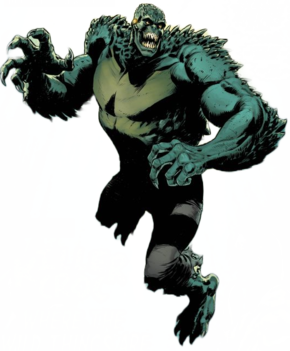
Killer Croc is a supervillain appearing in American comic books published by DC Comics. Created by Gerry Conway, Don Newton and Gene Colan, the character was introduced in Batman #357. He has become one of the most enduring enemies of the superhero Batman and belongs to the collective of adversaries that make up his rogues gallery.

Jason Peter Todd is a character appearing in American comic books published by DC Comics. First appearing in Batman #357 in March 1983, he was created to succeed Dick Grayson as Robin, Batman's partner and sidekick. Initially sharing a similar origin to Grayson, his character's origin was rewritten after the Crisis on Infinite Earths event. His origin, which has since been the standard for most iterations of the character, re-imagined Todd as an orphaned pre-teen living alone in Gotham City who came from an abusive family and was forced to partake in crime from an early age to survive who was taken in by Batman as his adopted son and protégé.
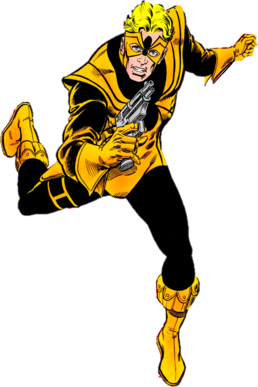
The Tarantula is the name of two characters appearing in American comic books published by DC Comics.

Killer Moth is a supervillain appearing in comic books published by DC Comics, usually as an adversary and dedicated original foil personality of Batman. Like Batman, he has no superpowers and relies on his technical equipment, including a Mothmobile and numerous gimmicks. Killer Moth originally wore a garish costume of purple and green striped fabric, with an orange cape and moth-like mask. In Underworld Unleashed, Killer Moth is transformed into the monster Charaxes with superhuman abilities.

Firefly is a supervillain appearing in American comic books published by DC Comics. Created by France Herron and Dick Sprang, he made his debut in Detective Comics #184. Initially portrayed as a criminal who utilized lighting effects to commit robberies, Firefly was later reimagined as a sociopathic pyromaniac with an obsessive compulsion to start fires following Crisis on Infinite Earths' reboot of the DC Universe in the 1980s. This darker depiction of the character has since endured as one of the superhero Batman's most recurring enemies and belongs to the collective of adversaries that make up his central rogues gallery.

Calendar Man is a supervillain appearing in American comic books published by DC Comics, as an enemy of the superhero Batman, belonging to the collective of adversaries that make up Batman's rogues gallery. Calendar Man is known for committing crimes that correspond with holidays and significant dates. He often wears costumes to correlate with the date of the designated crime. His name is a reference to the Julian and Gregorian calendars. In his debut, the character was presented as a joke villain, but in later years, writers developed Calendar Man as a dark, disturbed criminal who toys with Batman.
Blockbuster is the name of four supervillains and a criminal organization appearing in American comic books published by DC Comics. The first iteration was an adversary of Batman and Robin, while the second served as one of Nightwing's greatest enemies. The latest version first appeared in the pages of the series 52 wherein he is directed into battle against Lex Luthor's team of superheroes.

The Electrocutioner is an alias used by three fictional characters in the DC Universe, all minor enemies of the superhero Batman.
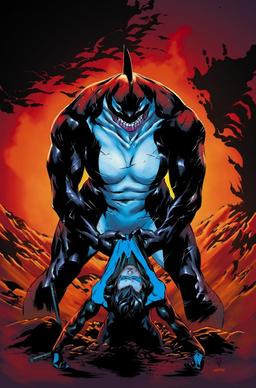
Orca is the name of two fictional anti-hero characters who appear in American comic books published by DC Comics, commonly known as one of the adversaries to the superhero Batman.

In addition to DC Comics books, the superhero Robin also appears in other media, such as films, television and radio. Dick Grayson, Jason Todd, Tim Drake, Stephanie Brown, and Damian Wayne are examples of the characters who use the name Robin.

Gotham Underground is a nine-issue limited series from DC Comics, written by Frank Tieri, with art by Jim Califiore.

The Court of Owls is a criminal organization and secret society appearing in American comic books published by DC Comics. They appear as adversaries of the superhero Batman. Created by writer Scott Snyder and artist Greg Capullo, the Court is described as an organization of the wealthiest and most influential citizens of the city of Gotham, having existed since the city's founding and completely unknown among its general population outside of an urban legend centered around their reputation for grisly assassinations carried out by indoctrinated agents known as Talons. The 2015–2016 "Robin War" story line details their international expansion, with the group renaming itself the Parliament of Owls.

David Dastmalchian is an American film, television, and stage actor. He has had supporting roles in a number of superhero franchises; he portrayed Thomas Schiff in The Dark Knight (2008), Kurt and Veb in the Ant-Man franchise, Abra Kadabra in The CW's The Flash, and Polka-Dot Man in The Suicide Squad (2021). He has also appeared in three of Denis Villeneuve's films: Prisoners (2013), Blade Runner 2049 (2017), and Dune (2021). Dastmalchian wrote and starred in the semi-autobiographical film Animals (2014). He had a supporting role in The Boogeyman and portrayed William Borden in Oppenheimer.
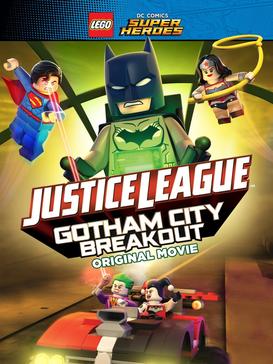
Lego DC Comics Super Heroes: Justice League – Gotham City Breakout is a 2016 American animated superhero comedy film based on the Lego and DC Comics brands, which was released on June 21, 2016 in Digital HD and on July 12, 2016 on Blu-ray and DVD. It is the sixth Lego DC Comics film following Lego Batman: The Movie – DC Super Heroes Unite, Lego DC Comics: Batman Be-Leaguered, Lego DC Comics Super Heroes: Justice League vs. Bizarro League, Lego DC Comics Super Heroes: Justice League – Attack of the Legion of Doom and Lego DC Comics Super Heroes: Justice League – Cosmic Clash. Some actors from various DC properties reprise their respective roles, including Nolan North as Superman, Grey DeLisle as Wonder Woman and Troy Baker as Batman. The film received positive reviews, with praise for the action, although the consumerism was criticized.

The supervillain the Penguin, created by Bob Kane and Bill Finger, made his first appearance in Detective Comics #58. Since then, he has been adapted into other forms of media, including feature films, television series, and video games.

